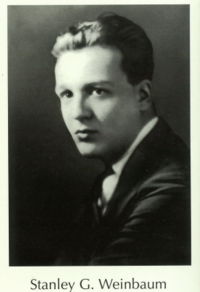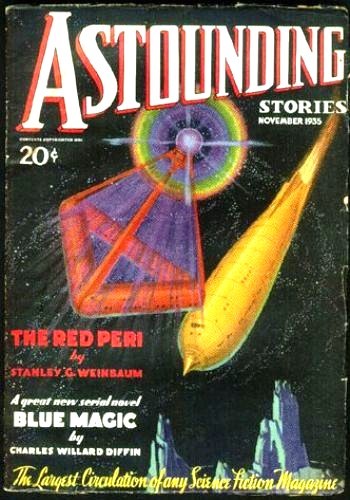 Stanley G. Weinbaum (April 4, 1902–December 14, 1935) published only a couple of dozen genre stories in his brief eighteen-month career before he was stricken with, and died from, cancer. His most famous story, “A Martian Odyssey,” appeared in the July, 1934 issue of Wonder Stories, and redefined how SF readers and writers conceptualized “the alien” from that point forward. Isaac Asimov called it one of the three seminal stories in science-fiction. Two SF novels were published posthumously, and have been reprinted several times over the years; The New Adam (1939) and The Black Flame (1948). Both are worth seeking out wherever they can be found. The New Adam, when I first found it on a spin-rack in a drug store in late summer of 1969 (an Avon pb for 75 cents), in Joplin, Missouri while on a visit to a dying grandparent, made an indelible impact upon my burgeoning intellectual, and somehow emotional (at age 18) development. The lonely genius portrayed in The New Adam has stuck with me ever since, though I’ve forgotten the details of the story. I still have that tattered paperback with the Jeff Jones cover.
Stanley G. Weinbaum (April 4, 1902–December 14, 1935) published only a couple of dozen genre stories in his brief eighteen-month career before he was stricken with, and died from, cancer. His most famous story, “A Martian Odyssey,” appeared in the July, 1934 issue of Wonder Stories, and redefined how SF readers and writers conceptualized “the alien” from that point forward. Isaac Asimov called it one of the three seminal stories in science-fiction. Two SF novels were published posthumously, and have been reprinted several times over the years; The New Adam (1939) and The Black Flame (1948). Both are worth seeking out wherever they can be found. The New Adam, when I first found it on a spin-rack in a drug store in late summer of 1969 (an Avon pb for 75 cents), in Joplin, Missouri while on a visit to a dying grandparent, made an indelible impact upon my burgeoning intellectual, and somehow emotional (at age 18) development. The lonely genius portrayed in The New Adam has stuck with me ever since, though I’ve forgotten the details of the story. I still have that tattered paperback with the Jeff Jones cover.
The most recent, and most welcome reprint of any of Weinbaum’s works comes from the astute publishers at Tachyon Publications, with publisher Jacob Weisman’s The Black Flame, which is totally different from The New Adam, but just as engaging. I highly recommend this novel, and point you to Tachyon Publications webpage.
The story we give you here, “The Adaptive Ultimate,” first ran in the November, 1935 issue of Astounding Science Fiction (ASF), and is perhaps the last story (of two) Weinbaum saw in print before his death. Weinbaum was so prolific in his short career, splitting his tales (mostly) between Wonder Stories and ASF, that he employed the pseudonym of John Jessel for some of his work. The November, 1935 issue of ASF is a case in point, for two of his stories appeared within its pages; a novella, “The Red Peri,” under his own name, and the novelette “The Adaptive Ultimate” as by John Jessel. The cover of the November, 1935 issue of ASF is pictured below.
 The late SF historian Sam Moskowitz, in his introduction to the 1966 Lancer edition of Weinbaum’s collection A Martian Odyssey and other great science-fiction stories, says of “The Adaptive Ultimate”:
The late SF historian Sam Moskowitz, in his introduction to the 1966 Lancer edition of Weinbaum’s collection A Martian Odyssey and other great science-fiction stories, says of “The Adaptive Ultimate”:
“In ‘The Adaptive Ultimate’ Kyra Zelas, a sickly, unattractive, dying girl is injected with a serum that turns her into a superwoman, capable of adapting physically even to knife and gun wounds and morally to the questionable ethics easing the path to survival and power. Completely amoral, except in her love for Dr. Daniel Scott, the man who has changed her through his scientific knowledge, Kyra Zelas sets out to bring the nation under her power.
“Despite the fact that he, too, is in love with her, Scott makes a series of attempts to destroy Kyra Zelas, providing drama so effective that the story was produced three times on television, once as a full-length show for Studio One and was adapted for motion pictures, appearing under the title of She-Devil.”
The Studio One television show Moskowitz refers to was titled “Kyra Zelas,” and aired on September 12, 1949, and the movie She-Devil appeared in 1957. What the usually thorough Moskowitz failed to mention, however, was the following radio adaptation of Weinbaum’s “The Adaptive Ultimate,” which aired on Escape (1947-1954) on March 26, 1949. As was usual with Escape, the adaptation and production values are quite good.
In 2008 the Cordwainer Smith Rediscovery Award went to Stanley G. Weinbaum. Interesting of note also is that Weinbaum has a crater on Mars named after him. Credited as being written by John Jessel, we hope you enjoy this dramatization of Stanley G. Weinbaum’s “The Adaptive Ultimate.”
Play Time: 29:30